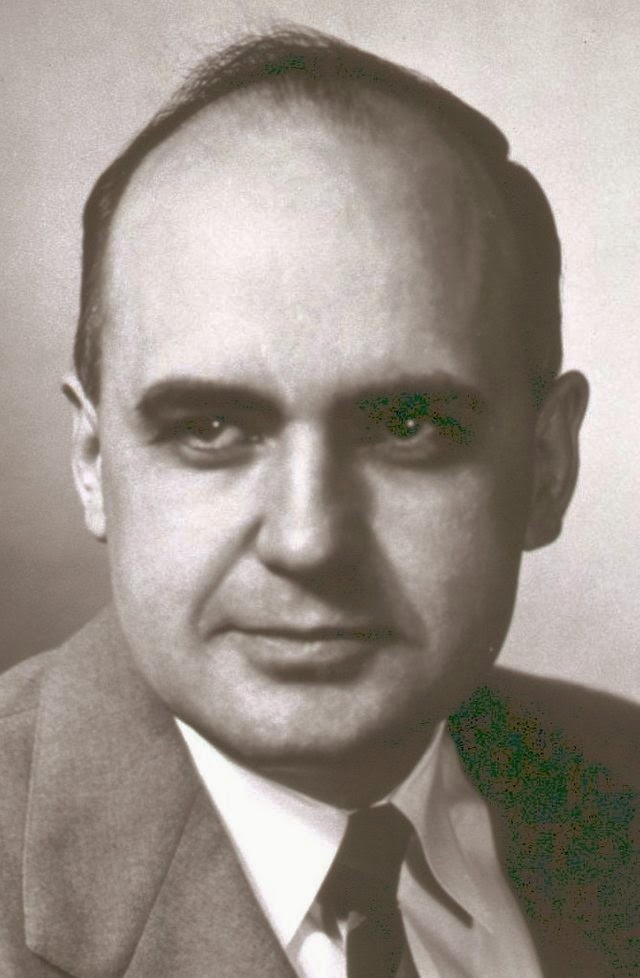30th august is very important in the history of science because-
 |
| Maurice R. Hilleman (courtesy-Wikipedia)
Maurice R. Hilleman American microbiologist was born today in 1919. Hilleman specialized in vaccinology and developed over 36 vaccines, more than any other scientist. Of the 14 vaccines routinely recommended in current vaccine schedules. He developed vaccines for measles, mumps, hepatitis A, hepatitis B, chickenpox, meningitis, pneumonia and Haemophilus influenzae bacteria. He also played a role in the discovery of the cold-producing adenoviruses, the hepatitis viruses, and the cancer-causing virus SV40. He is credited with saving more lives than any other medical scientist of the 20th century. He is remembered as "the most successful vaccinologist in history". Hats off to a saviour like him. Hilleman died on 11th April 2005 at the age of 85.
John William Mauchly an american engineer and physicist was born today in 1907. Mauchly in 1946 invented the Electronic Numerical Integrator and Computer (ENIAC), the first general-purpose electronic computer. It was the size of a three-bedroom apartment, weighed 30 tons, and cost nearly half a million dollars to build-and $650 an hour to run. But in 1945, this behemoth was the cutting edge in technology, and a herald of the digital age to come. This "little gem of a book" tells the story of this machine and the men who built it-as
(Courtesy- history-computer.com)
well as the secrecy, controversy, jealousy, and lawsuits that surrounded it-in a compelling real-life techno-thriller.
ENIAC (courtesy- Wikipedia)
ENIAC contained 17,468 vacuum tubes, 7,200 crystal diodes, 1,500 relays, 70,000 resistors, 10,000 capacitors and around 5 million hand-soldered joints. It weighed more than 30 short tons (27 t), was roughly 8 by 3 by
It is the birthday of Sir Ernest Rutherford a New Zealand-English physicist who is known as the father of nuclear physics. He was born on 30 Aug 1871.
(Courtesy-Wikipedia)
Encyclopædia Britannica considers him to be the greatest experimentalist since Michael Faraday. In early work he discovered the concept of radioactive half-life, proved that radioactivity involved the transmutation of one chemical element to another, and also differentiated and named alpha and beta radiation. It is the basis for the Nobel Prize in Chemistry he was awarded in 1908 "for his investigations into the disintegration of the elements, and the chemistry of radioactive substances". In 1907 he and Thomas Royds proved that alpha radiation is helium ions.
Vacuum cleaner was discovered today in the year 1901 by a British engineer Hubert Cecil Booth (
(Courtesy-Wikipedia)
Story of its invention is quite interesting. Booth witnessed a demonstration of a new cleaning machine for railway cars. This machine was like no other he had seen. It took the dust from one side of the car and sent it to a dustbox on the other side. He decided to take this idea into the home. The idea of a vacuum cleaner had been around for some time before. The first vacuum cleaner was a 2-man show. 1 person had to operate the bellows while the other moved the mouthpiece across the floor. However, this was not a vacuum cleaner as we know it today. This one actually just blew the dust into the air and scattered it about. With no means of removal, the dirt simply used to settle again. Once struck with the idea of using suction, Booth made a preliminary experiment by placing a pocket handkerchief over the plush back of a seat. He put his lips to it, and after sucking, a ring of black spots on the handkerchief proved his principle. He started a mobile cleaning service. Built on a horse-drawn cart, his vacuum machine had an engine driving a pump provided with a long hose to extend into a house to be cleaned. An early task was to clean the great blue coronation carpet in Westminster Abbey for Edward VII's coronation. Later he became Chairman and Managing Director of the British Vacuum Cleaner and Engineering Co. |




No comments:
Post a Comment